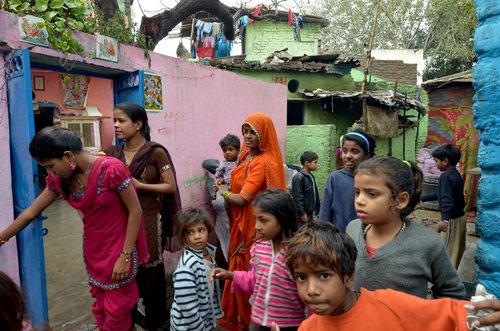 It’s early morning in a Mumbai train station. The video is grainy, but you can clearly make out a dense swarm of humanity along the platform. By my count, the crowd stands at least ten or twelve people deep, males for the most part, many dressed in light short-sleeved shirts, the kind you’d wear in an office. As the train rumbles into the station, the men surge forward as if one. It’s the first stop along the route, and in seconds the train is sardine-can full.
It’s early morning in a Mumbai train station. The video is grainy, but you can clearly make out a dense swarm of humanity along the platform. By my count, the crowd stands at least ten or twelve people deep, males for the most part, many dressed in light short-sleeved shirts, the kind you’d wear in an office. As the train rumbles into the station, the men surge forward as if one. It’s the first stop along the route, and in seconds the train is sardine-can full.
Local observers say that if you want to understand just how congested Indian cities are today, try squeezing into one of Mumbai’s commuter trains. And indeed such Indian scenes of teeming humanity have become enduring memes for the problem of human overpopulation. In 1960s, for example, Stanford University ecologist Paul Erhlich and population biologist Anne Ehrlich gazed from a car in growing horror as they wound through the streets of New Delhi.  Everywhere they looked, the Ehrlichs saw “people eating, people washing, people sleeping,” as they later noted in The Population Bomb. For the Ehrlichs, the teeming streets were a bellwether of disaster: famine, they concluded, was inevitable. The only possible solution for India was sterilization—forced sterilization if need be.
Everywhere they looked, the Ehrlichs saw “people eating, people washing, people sleeping,” as they later noted in The Population Bomb. For the Ehrlichs, the teeming streets were a bellwether of disaster: famine, they concluded, was inevitable. The only possible solution for India was sterilization—forced sterilization if need be.
I read The Population Bomb as a university student, and was deeply impressed by its message, as were so many of my generation. But today few of the Erhlichs’ dire predictions of global famine have come to pass. And while India did indeed impose a mass sterilization campaign in the mid-1970s—denying food rations and other key government programs to the unsterilized—poor Indians rioted in the streets, forcing officials to jettison the campaign.
But then a strange thing happened to India’s fertility rate. Instead of soaring dramatically, it declined. And it has dropped steadily since. Today, according to the World Factbook, India boasts a Total Fertility Rate of 2.55—a little more than the United States, whose rate is 2.1, but much lower than Guatemala at 3.92, Afghanistan at 5.54 or Uganda at 6.06. (The Total Fertility Rate is the average number of children women would have if they lived to menopause and bore children at a given fertility rate.)
So what accounts for this surprising decline? Historical geographer Martin Lewis at Stanford University recently wrestled with this question in a lengthy post on one of my favorite blogs, GeoCurrents. Lewis noted, first off, that India’s total fertility rate didn’t fall in a uniform way across the subcontinent: that, of course, would be far too simple. Instead, provinces in the south and in the far north and far north east had rates in 2012 of 1.9: those in the heartland were as high as 3.5.
Demographers and geographers had previously proposed several possible explanations for India’s overall fertility decline—increased rates of female education; economic development; urbanization; and technological innovation. So Lewis mapped geographic data for each of these variables in India. Then he compared each of the resulting maps to India’s fertility rate map. The geographic distribution of female education and economic development compared quite well with low fertility rates. But what Lewis discovered is that the geographic pattern of one variable—television ownership—looked an awful lot like that of the fertility rates. Where television ownership is common in India, fertility rates are generally low.
 Lewis concedes that these correlations don’t constitute causation. But he suggests that television-viewing likely exposes women to middle-class values and modern ideas about small families. And not just any television-viewing: soap operas are particularly influential. In Brazil, for example, economist Eliana La Ferrara and her colleagues found a strong geographic correlation between lower fertility rates and the spread of the television signal of Redo Globo, a network famous for its exceptionally popular soap operas, or novelas. These programs idealize small families—something not lost on poor women.
Lewis concedes that these correlations don’t constitute causation. But he suggests that television-viewing likely exposes women to middle-class values and modern ideas about small families. And not just any television-viewing: soap operas are particularly influential. In Brazil, for example, economist Eliana La Ferrara and her colleagues found a strong geographic correlation between lower fertility rates and the spread of the television signal of Redo Globo, a network famous for its exceptionally popular soap operas, or novelas. These programs idealize small families—something not lost on poor women.
The “presence of the Globo signal,” concluded La Ferrara and her colleagues in a 2008 paper, “leads to significantly lower fertility. This effect is stronger for women of low socioeconomic status, as measured by education or durable goods ownership. The effect is also stronger for women who are in the middle and late phases of their child-bearing life, suggesting that television contributed more to stopping behavior than to delayed first births, consistent with demographic patterns documented for Brazil.”
I confess that I was taken aback by all these findings. Like many other feminists of my generation, I’ve long slagged shows like Days of Our Lives and The Young and the Restless. But it turns out that soaps may be a potent force for the good in the developing world. Lewis now suggests that the best way to lower fertility rates in countries like Uganda may involve working on three fronts: educating girls; promoting economic development; and bringing electricity, televisions and soap operas to poor communities.
Who would have thought?
On a personal note, this is my last post as a regular LWONer. It’s been a great ride, and you’ve been wonderful readers – perceptive, discerning, informed, and generous with your comments. When LWON was born, we could never have foreseen such an engaged and engaging community of readers. Thank you for everything. I’m off now to get serious about writing a new book. I hope to return from time to time as a guest writer. I hate the word goodbye.
Photos: Mumbai Train Station, Children in the Slums of New Delhi, and Indian rural house with satellite antenna, all courtesy Shutterstock
An alternative explanation is that ownership of a TV gives couples something else to do at night, regardless of the programming.
Good luck with the book, and please make your guest posts frequent.
In a developing country, television ownership is likely to correlate with wealth, and increasing wealth correlates with lowered numbers of children per couple cross-culturally. See Wikipedia: Demographic-economic paradox.
Like Eadwacer, I’m also having a hard time seeing why one would assume the effect was purely the result of watching soap operas or even that the effect was primarily the result of changes in women’s behavior. Given the unequal status of women, I’d at least consider the idea that it’s primarily men who change their reproductive behavior when they have a television in the house. It’s too bad that there’s no data on the men, but we can probably assume that an older woman has an even older man for a husband. It may be that it’s soccer that lowers fertility.
Thanks Eadwacer for your good wishes. And yes, I agree with all of you that Lewis’s work doesn’t prove that women who watch soap operas absorb modern ideas about the value of small families. But Lewis does test the possible correlation between increasing wealth and lower fertility. If you check his post Stephan, you will see that he compares a map of per capita GDP across India with that of total fertility rates. He finds poor areas with low fertility rates and relatively rich areas with high fertility rates.
Of course, it’s possible that simple TV watching or watching soccer could lower total fertility rates. But there’s no data to suggest this. And there is data–admittedly in Brazil– supporting the soap opera idea.